EDIT: In addition to this session re-cap, I have also written a GENERAL REVIEW of this game, for those who’d like additional insight.
Two weeks ago, I wrote a generally favorable review of the family role-playing-game No Thank You, Evil!, by Monte Cook Games. This past weekend was our first official foray into the land of Storia. I brought my overly-extensive GMing experience with me, and I facilitated for my two sons the first pre-fabricated adventure module from the base set, entitled “Lost in Dragonsnot Falls.” I thought I’d post some of the highlights of the session as a follow-up to my review, especially for those of you considering this title for your own kids.
We planned to actually play the session itself on Sunday, but I set aside time on Friday for the boys to generate their characters. I didn’t want to do too much in a single sitting, lest I exceed their attention span, and I wanted to make sure they put their full creative focus into making their characters, for maximum fun. This is what we ended up with (which I had also immediately shared on Twitter and Facebook):
The 8-year-old’s character:
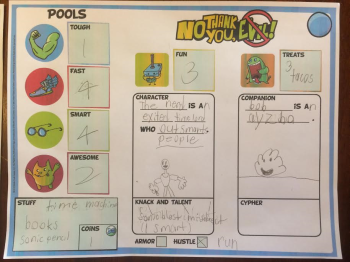 The Nerd. An “excited” Time Lord who outsmarts people. Has a knack with a sonic blasting pencil and a special talent for misdirection. His creature companion is Bob, an ayzbo (pronounced “eyes-bo”) with a predilection for tacos. It will come as no surprise that my son is really into Doctor Who at present, but I think this creature he called an “ayzbo” (which he drew more like a cloud but described more like an urchin) was inspired more by the cast of Gumball.
The Nerd. An “excited” Time Lord who outsmarts people. Has a knack with a sonic blasting pencil and a special talent for misdirection. His creature companion is Bob, an ayzbo (pronounced “eyes-bo”) with a predilection for tacos. It will come as no surprise that my son is really into Doctor Who at present, but I think this creature he called an “ayzbo” (which he drew more like a cloud but described more like an urchin) was inspired more by the cast of Gumball.
The 5-year-old’s character:
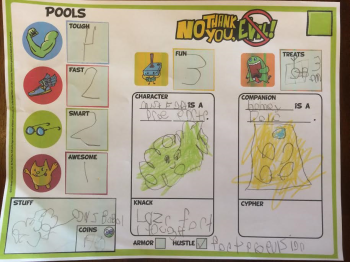 Mister Farts. As you might have guessed, he’s a professional farter. So professional, he can shoot a laser fart from his butt and use short gaseous bursts to propel himself through evasive combat maneuvers. In fact, his physical form is little more than a nebulous green cloud. His creature companion is Bomey (bomb-y), a Dalek-turned-good who fuels himself with, well… bombs. We decided that the way a Dalek “eats” things is by absorbing them into his armored outer-plating. Our five-year-old has also been watching Doctor Who with us, and there was a point where he wanted to totally change his character and also be a Time Lord (like his big brother), but I encouraged him to stick with his original creation because it was funny and original.
Mister Farts. As you might have guessed, he’s a professional farter. So professional, he can shoot a laser fart from his butt and use short gaseous bursts to propel himself through evasive combat maneuvers. In fact, his physical form is little more than a nebulous green cloud. His creature companion is Bomey (bomb-y), a Dalek-turned-good who fuels himself with, well… bombs. We decided that the way a Dalek “eats” things is by absorbing them into his armored outer-plating. Our five-year-old has also been watching Doctor Who with us, and there was a point where he wanted to totally change his character and also be a Time Lord (like his big brother), but I encouraged him to stick with his original creation because it was funny and original.
A Little Bit o’ Prep
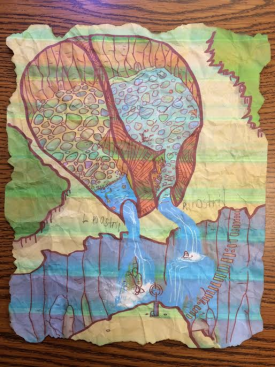 It wasn’t required, but I did a little extra materials prep for fun. The game manuals provide all the illustrations and maps needed—and even “needed” is a debatable term in an RPG. These are all essentially “props” that add flavor to the experience. With an older crowd or more “serious” RPG players, they can tend to feel a little gimmicky, but I thought they’d be good for the kids in this case. I printed, cut, and laminated all the illustrations for the module as individual “photos” the boys could hold onto for reference. I also doctored a map handout to make it seem old and worn. Neither this nor the lamination was at all necessary, but what can I say? I’m a geek playing a game of fantasy with my boys. The more toys the better. And it turned out that having the physical things to hold onto (rather than just flashing them the pictures from the script) was very helpful for them.
It wasn’t required, but I did a little extra materials prep for fun. The game manuals provide all the illustrations and maps needed—and even “needed” is a debatable term in an RPG. These are all essentially “props” that add flavor to the experience. With an older crowd or more “serious” RPG players, they can tend to feel a little gimmicky, but I thought they’d be good for the kids in this case. I printed, cut, and laminated all the illustrations for the module as individual “photos” the boys could hold onto for reference. I also doctored a map handout to make it seem old and worn. Neither this nor the lamination was at all necessary, but what can I say? I’m a geek playing a game of fantasy with my boys. The more toys the better. And it turned out that having the physical things to hold onto (rather than just flashing them the pictures from the script) was very helpful for them.
I also wanted to do a little “environmental” prep, just to try and lock in the boys’ attention and lock out distractions from TV, tablets, toys, etc. My boys have a bunk bed, which converts very easily into an official bedroom fort with just a few blankets. I brought a small lamp into our cell with us, and we closed ourselves off from the world for our session.
The Adventure
I made zero modifications to the script at all, with the exception of one or two minor ad-libs in the middle of play, which are to be expected. There were actually fewer ad-libs than I had anticipated. I wanted to run the module as close to its original design as possible so I could get a true gauge of how well it fit and whether or not future adjustments would be appropriate. The whole thing probably took 90 minutes, not including several breaks we took. Part of this longer-than-expected play time was due to explaining rules (more than once), so I expect future sessions will move faster.
The breaks we took were to prevent monotony and to maintain the kids’ interest. However: (a) the 8-year-old didn’t really need them and probably could have played a full, 8-hour Dungeons & Dragons session, and (b) the breaks didn’t seem to help with the 5-year-old. Despite his enthusiasm during character generation a couple days earlier, we lost him almost right away during the actual session. Obviously, different kids have different proclivities and will respond in different ways, but I think for my boy, the game was a little bit too cerebral for him. He responded well when given something to do; for example, we had a scene where the characters were going to take a nap, so I directed the boys to write or draw on the back of their character sheets what their characters dreamed about. He took to this well. But whenever the game involved passively listeni ng, or even actively brainstorming, he didn’t seem all that engaged. This isn’t surprising, really. This kid is physical to the max. When he’s playing little league baseball, he breakdances in the outfield and thinks the dugout is a jungle gym.
Before the gaming session was over, the 5-year-old had completely abandoned our fort and was playing with a light saber and a NERF gun instead. His in-game character was “accidentally” transformed into a snail due to a magical mishap, ending up as part of his brother’s inventory for the remainder of the session. (So-called “accidents” regularly happen in RPGs, by the way, commensurate with the needs of the game and the spitefulness of the GM…) There’s a pretty good chance that, if we added miniature figures and more objects to the game, to increase the kinesthetic/toy factor, he might be more engaged. (When we play other tabletops, he quite literally can’t keep his hands off the components.) Moreover, this kid may simply be more cut out for LARPing instead…
As for my 8-year-old, he simply ate it up. Every time I suggested taking a break, he moaned and groaned, ready to just power through. He surprised me with his initiative and his natural inclination to ask the right questions and seek the right clues for interacting with the fantasy. And the role-playing was no problem at all. Of course kids are almost always more ready to play-act and do funny voices than their adult counterparts, but I have to say, he inspired me. Even a seasoned GM surrounded by loving friends gets a little nervous with the “acting” component of an RPG. My boy brought out the kid in me for sure. We came to a final scene of the adventure that involved our heroes rescuing a hapless friend from the captivity of some witches. The friend, an NPC under my direction, was too scared to try and sneak past the guards, at which point my son, in character, said, “Niffles, we need to get past those witches, so I need you to be brave.” It was awesome. Extra experience points (“Fun Points”) were awarded.
Next Time
Now that I’ve gotten a sense of the boys’ respective engagement levels, I’m planning for the next session. I plan to write the next module myself, since I think the boys, especially the older one, can handle a little more challenge and complexity than what’s in the starter set. As part of this, I intend to do a little more “central planning” and calibration in terms of which character traits are tapped and how many “tough points” the characters will be risking, so there will be more attrition and long-term consequences. I will be introducing a house rule to adjust how rolls are made, since right now I feel like the current system doesn’t fully build on the characters’ different strengths and weaknesses. There will be more of a team/cooperative feel if the players can discuss who is stronger at varying tasks (and if they accept certain things that their respective characters aren’t good at), and they can learn how to rely on each other. I’m going to look for ways to add more “tabletop” elements like you’d find in a dungeon crawler, so there will be more manipulatives. I think I’ll also include more kinesthetic and live-action elements. The game already encourages the players to be creative and build story elements on their own, mainly through speaking, writing, and drawing. I think my younger son would appreciate the chance for a bit of his “interpretive dance” as well.
You are invited to subscribe to this blog feed and/or to leave comments using the forms below. If you enjoy what we produce here at Past Go, please consider becoming a patron of ours on Patreon. Even the smallest donation is gratefully received. May you be happy.

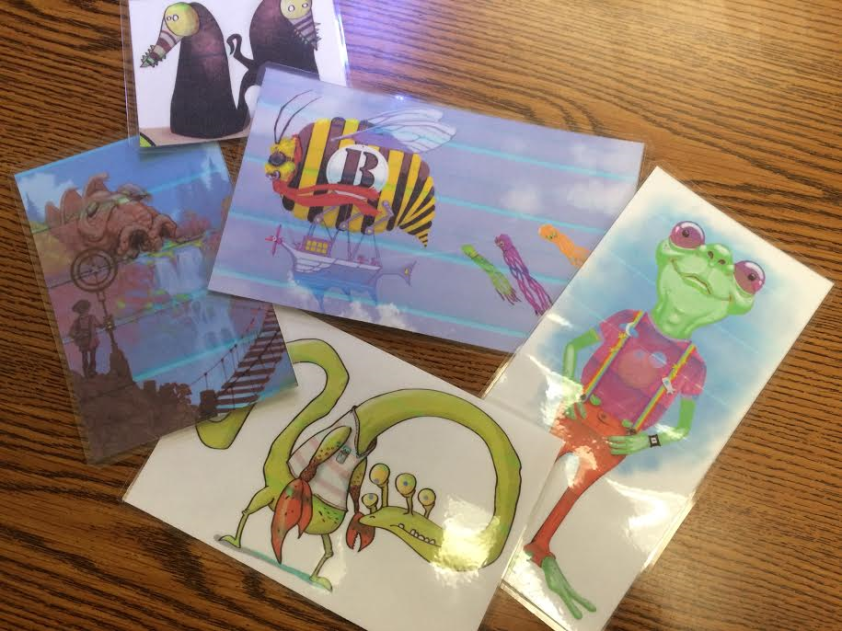
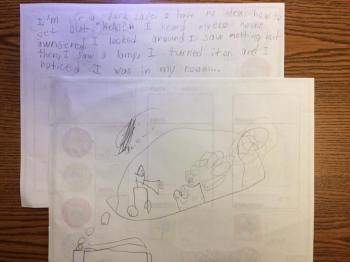

The Nerd is an “excited time Lord who outsmarts people.” Love it! Nice job!
LikeLiked by 1 person
Pretty much sums it up, right?
LikeLike